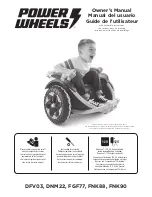
12
Owner’s Guide
INTRODUCTION
Read all of SAFETY and this section before attempting any procedure. Pay particular attention to Notices, Cautions, Warnings and Dangers.
3. Direction Selector
To prevent loss of control or possible damage to the vehicle, do not
move the direction selector while the vehicle is in motion.
The direction selector is found on the seat wrap panel and allows the operator to
select F (forward) or R (reverse) or N (neutral).
When the direction selector is moved to the R position, a reverse warning buzzer
activates.
4. Accelerator Pedal
Accidental movement of the accelerator pedal can cause the vehicle to suddenly move and cause
severe injury or death.
With the key switch in the ON position, press the accelerator pedal to start the motor. When the pedal is released, the
motor will stop. To stop the vehicle immediately, press the brake pedal.
5. Brake and Parking Brake Pedal
The foot operated parking brake is the top part of the brake pedal. To engage the
parking brake, press on the upper section of the pedal until it locks in position.
Press the lower part of the brake pedal to release the parking brake.
A parking brake that is engaged releases when you press the accelerator pedal.
This is a feature to make sure the vehicle is not driven with the parking brake
engaged. Pressing the accelerator pedal is not the recommended method to
release the parking brake.
6. Charger Receptacle (if equipped)
The polarized charger receptacle is found on the panel below the driver seat.
Connect the off board charger to the receptacle to charge the batteries.
7. CE Charger Receptacle (if equipped)
The CE charger receptacle is found on the panel below the driver seat.
Connect the CE charger to the receptacle to charge the batteries.
3
5
4
6
7

































